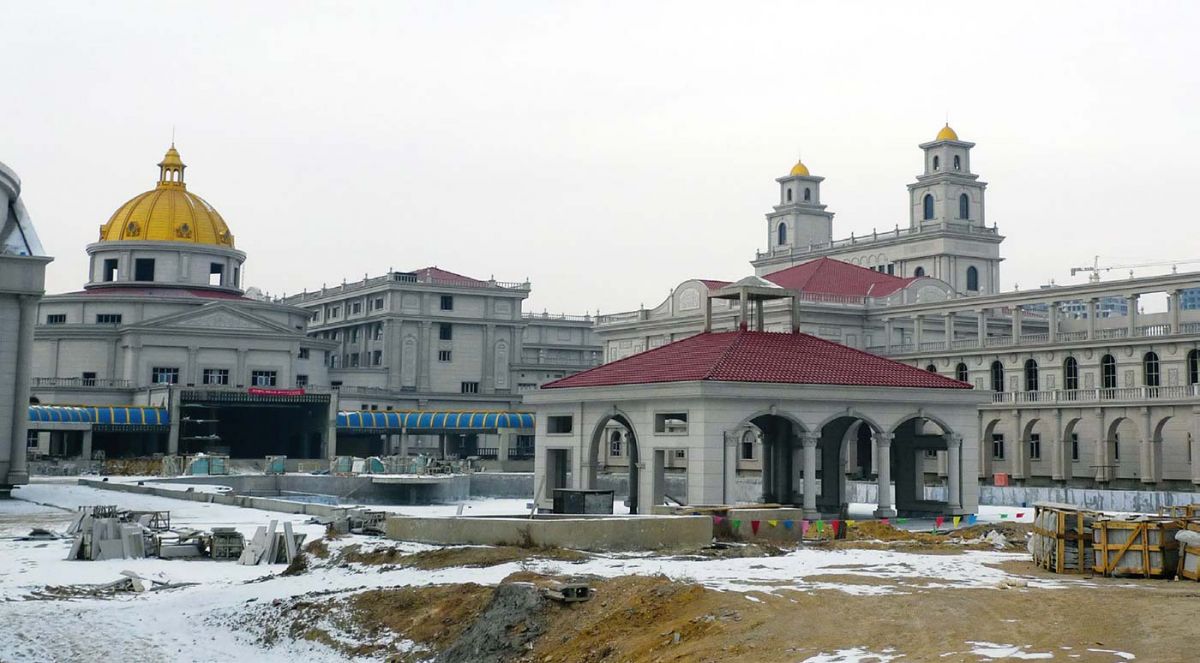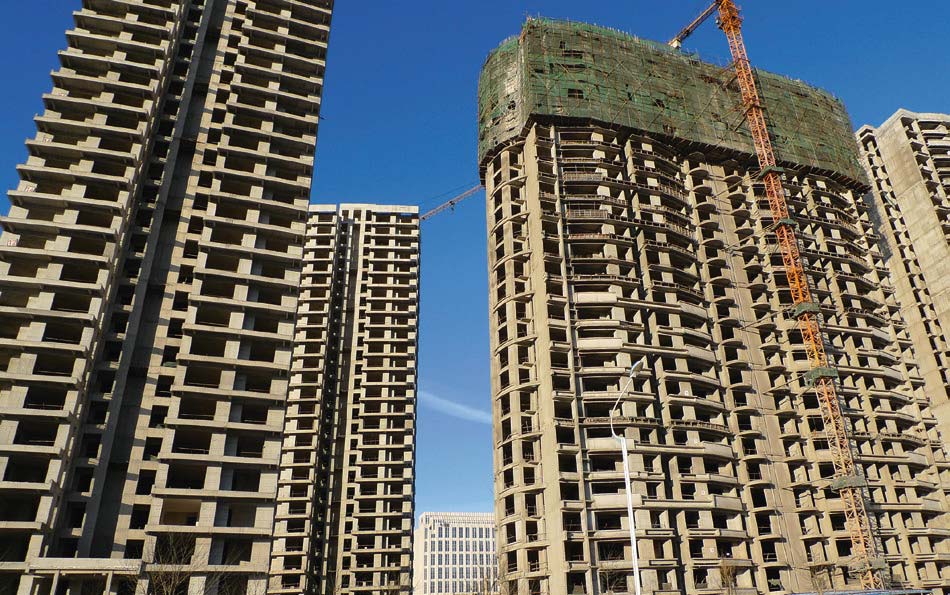Boomtown in ruins: Ordos and ruination
In the 2000s, China’s economy grew at an average annual rate of nearly 7 percent.[i] Recent talk of a ‘new normal’ foresees slightly slower growth rates closer to 6 percent extending into the medium-term future – a rapid pace when compared with other large industrial economies historically. Within this broad growth picture, cities and their metropolitan regions have grown even faster, acting as the engines of the national economy. Central to all this metropolitan growth was a frenzy of urban construction of all types: private housing, office spaces, retail centers, roads, subways, parks, and so on. As any casual observer of Chinese cities can readily note, urban construction has been the order of the day for quite some time, and it drives local economies.
[i] For official statistics on economic growth, see the National Bureau of Statistics of China public database; https://tinyurl.com/npChinaAnnualData
This is also borne out by the numbers: between 2003 and 2014, over 300 million square meters of housing was added across China.[1] In most municipalities, property development and construction has accounted for nearly 40 percent of local GDP and fixed-asset investment during this period. Correspondingly, home prices have surged astronomically. The average per-square meter cost for private housing in Beijing, for example, is now US$6,000, roughly half of the average household annual income.[2] Given the rise in property prices, the sector has become a vibrant arena of speculation for the wealthy and fortunate, with property ownership now effectively separating the haves from the have-nots in urban China.
Energy boomtowns
While the growth of mega-cities on the eastern seaboard garners the most attention, a number of less-known cities of the central and western regions grew even faster than their eastern peers. Foremost among this subset of cities are energy resource boomtowns that have thrived off intensified resource exploitation. Ordos in Inner Mongolia Autonomous Region exemplifies western China’s energy boomtowns. Economic expansion in the city surged on the basis of rising energy demand and national energy policy favoring expanded production in a small number of locales concentrated in Western China. The urban component of boomtown growth was driven by forces familiar across all of China’s cities, specifically, local leaders’ encouragement of land and property development as a way to provide a source of extra-budgetary, and therefore wholly locally retained, municipal revenue and the use of urban growth projects of all sorts to spur economic growth. Private demand for properties also played a key role in driving growth. What distinguished Ordos in the 2000s has been the volatile combination of a burgeoning resource sector and surging urban development.[3] Investors from near and far sensed opportunities in the context of a resource boom and poured massive investments into real estate, triggering a frenzy of construction and igniting a speculative growth process as buyers and sellers led an upward spiral of prices that decoupled supply and demand from any reasonable assessment of the use value of properties. Prices rose steadily from the early 2000s until finally coming to a halt around 2011. The causes of the sudden end to rising prices are disputed and hard to trace with certainty. However, contributing to the demise of Ordos’ housing sector was a confluence of the following factors around 2011: declines in coal prices at the time, rising concerns that Beijing would soon move to aggressively attempt to reduce the growth rate in the use of fossil fuels, excess capacity in the coal sector, a roll-back of post-2008 stimulus programs, enforcement of stricter limits on property purchases, the simultaneous collapse of multiple Ponzi-type schemes funding much of the urban construction and home purchases. Whatever the causal forces of the crash, by mid-2011 Ordos’ urbanized areas were dotted with empty and abandoned projects as financing and buyers and sellers disappeared from the market. In plain terms, Ordos was convulsed by enormous speculative property bubbles and suffered a severe, but localized, economic crash.
Modern ruins
The uninhabited luxury villa compounds and vacated construction sites that still litter the landscapes of Ordos nearly ten years later reverberate recent debates about modern ruins and ruination.[4] The ‘modern ruins’ of capitalist development arise, Edensor notes, as waves of investment wash over places and then recede, leaving behind the detritus of industrial progress.[5] Thus, the creative destruction of capitalism produces ruins in formerly buzzing sites like Detroit or Manchester or Fordlandia, and does so on a continual basis in new places. As such, various types of ‘new ruins’ provide material reminders of the perpetual reproduction of destruction that is at the center of capital accumulation. Yet unlike erstwhile thriving spaces that have fallen to ruin, the ruinous landscapes of Ordos were never fully populated; a great number of newly built homes, storefronts, and offices were never used. Yet nearly all units in completed projects had, in fact, been purchased on a speculative basis. The ruins of urban projects in Ordos thus speak less to industrial capitalism and its precarious territorialization than to essential problems of time and value in the production of built environments through financial speculation. The city’s ruins might be regarded as referents of what Stoler refers to as the temporal and material process of ‘ruination’.[6]
In a variety of settings, the central role of finance has been noted in driving the speculative property bubbles of the twenty-first century. Ordos was no exception. However, the particular modes of finance that arose in the city were crucial to the specificity of its urban growth patterns – and to an understanding of how urban growth followed a decidedly ruinous course. Of special importance here were the tangled networks of informal finance that fed off rising incomes in the city and promised to mobilize savings toward high-profit sectors. As elsewhere in China, the property sector in Ordos offered abundant opportunities to see rapid returns. Moreover, with the resource sector effectively closed to all but the largest institutional investors given the scale of necessary investments and with local industry and commerce constrained by small population and geographical isolation, local residents sought outlets for savings other than bank accounts where officially set interest rates were lower than local inflation. Numerous forms of non-bank lending evolved in response, including micro-lending operations, pawn shops, underground banks, rotating savings and credit associations, and outright pyramid schemes. While each such mode of financing offered different terms, all featured high interest rates and short repayment schedules. It thus followed, that with such schemes mediating private savings toward land and property development, the pace of growth in Ordos’ property sector was fueled by the supply of high-interest fast financial capital and not by demand for the ever-growing stock of new properties. It was also clear that collusion and incompetence were salient elements of the bubble, as local officials joined the fray, leaning on loan officers in formal banks to extend credit to property developments, approving project after project, and engaging in risky borrowing and lending. By the time the bubble had burst in 2011, Ordos’ built-up urban area had ballooned more than tenfold from roughly 25 square kilometers to 270 square kilometers. Among the registered urban population, surveys found the average household held ten properties.
The municipal government responded to the twin crises in the local property market and informal finance in three main ways. First, it established an ad hoc office in 2012 to sort through claims by bilked lenders in informal lending networks. This entailed identifying borrowers and seizing their assets to compensate claimants. Second, municipal leaders applied pressure to local branches of state-run and commercial banks to extend loans to developers to keep the property market afloat. Neither approach restored Ordos’ economic growth, which had been inflated by the property bubble. Between 2012 and 2017, Ordos was the slowest-growing municipality in Inner Mongolia. Third, municipal authorities opted to wait out the downturn. As one local official explained in an interview in 2014, “there is nothing to do with all of these houses but wait until more people arrive, or see if another bubble will come”. This sentiment was widely shared in the city, as owners of multiple homes reasoned that future children and migrants would eventually fill the thousands of unused properties. “Everyone jokes about Ordos being a ‘ghost city’. But it’s only just recently built. It’s natural that it takes time for the people to arrive”.
Imagined futures
Such articulations of defiant optimism collected during fieldwork in the post-bubble years in Ordos contained a palpable resistance to the ‘ghost city’ narratives that the media used to characterize the city’s development. That narrative has hinged on diagnosing Ordos’ urban projects as useless excess now reduced to ruins. Fault for Ordos’ ‘failures’, according to much reporting on ‘ghost cities’, is laid at the feet of greedy, naïve investors and venal provincial officials who unwisely allowed supply and demand to become decoupled. Yet, as local residents’ rejection of such judgments suggests, the ruins that persist in the post-bubble moment index a more complicated set of realities. Indeed, a fixation on the absence of evident use values in the uninhabited built environments underpins the commonplace negative assessments of ‘ghost cities’. Moreover, it ignores how the financialization of the urbanization process brings forward in time the accumulation of surplus and is sustained by admixtures of hope and delusion, the essential and time-honored lubricants of capitalism. One need look no further than Wall Street to find a contemporary example in the so-called ‘advanced industrialized countries’.
Viewed outside the frame of failure that shadows the ghost city trope, Ordos’ abandoned and uninhabited cityscapes thus present object lessons in ruination qua accumulation. The ruins of Ordos’ property development projects don’t so much narrate a linear history of ascendance and decline as posit a reordering of time enabled by capitalist growth such that, as Smithson remarked, present forms “rise into ruin”.[7] For a time, fortunes were made in the creation of so much rubble. Now, in the face of crisis, people are advised to wait for the next round. In the meantime, the ruins of development sites linger as reminders, for some, of riches gained almost overnight through speculation and, for more than a few, of imagined futures that disintegrated just as suddenly.
Max Woodworth, Assistant Professor, Ohio State University
[1] See National Bureau of Statistics of China, China Statistical Yearbook; https://tinyurl.com/chinayearbook2014
[2] See ‘China’s Housing Market is Cooling’, Global Property Guide, 4 April 2018; https://tinyurl.com/gpgchina
[3] See Woodworth, M.D. 2015. ‘Ordos: A market-era resource boomtown’, Cities 43:115-132.
[4] See DeSilvey, C. & Edensor, T. 2013. ‘Reckoning with Ruins’, Progress in Human Geography 37(4):465-485.
[5] Edensor, T. 2005. ‘The ghosts of industrial ruins: ordering and disordering memory in excessive space’, Environment and Planning D: Society and Space 23(6):829-849.
[6] See Stoler, A.L. 2008. ‘Imperial debris: reflections on ruins and ruination’, Cultural Anthropology 23(2):191-219.
[7] See ‘The monuments of Passaic, New Jersey’, in Flam, J. (ed.) 1996. Robert Smithson: The Collected Writings. Berkeley: University of California Press.

